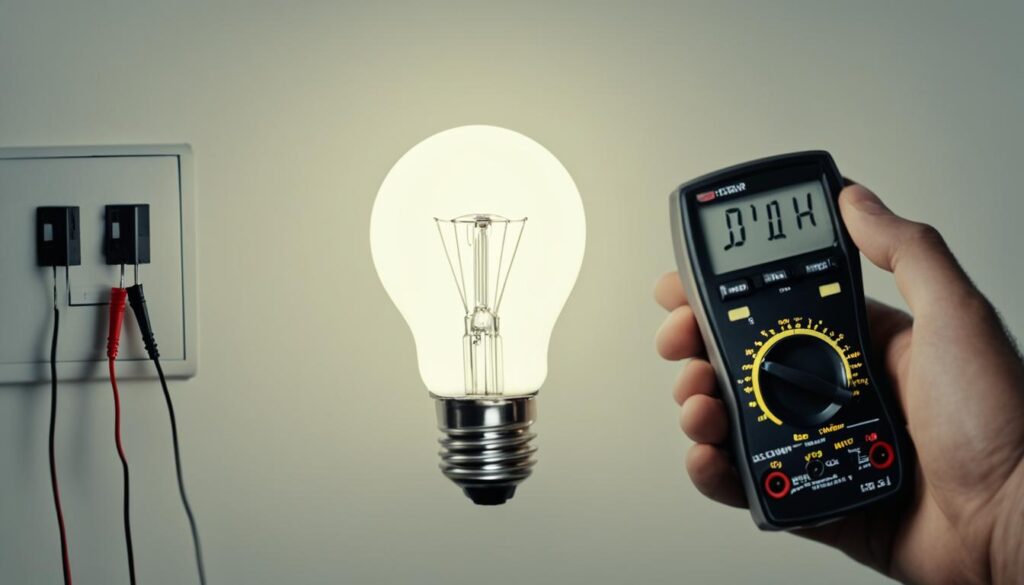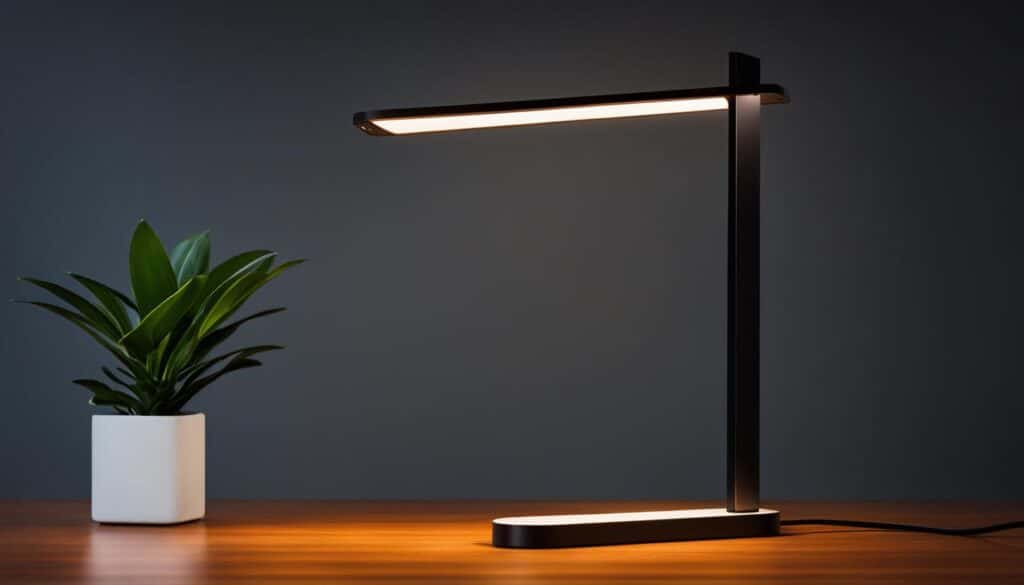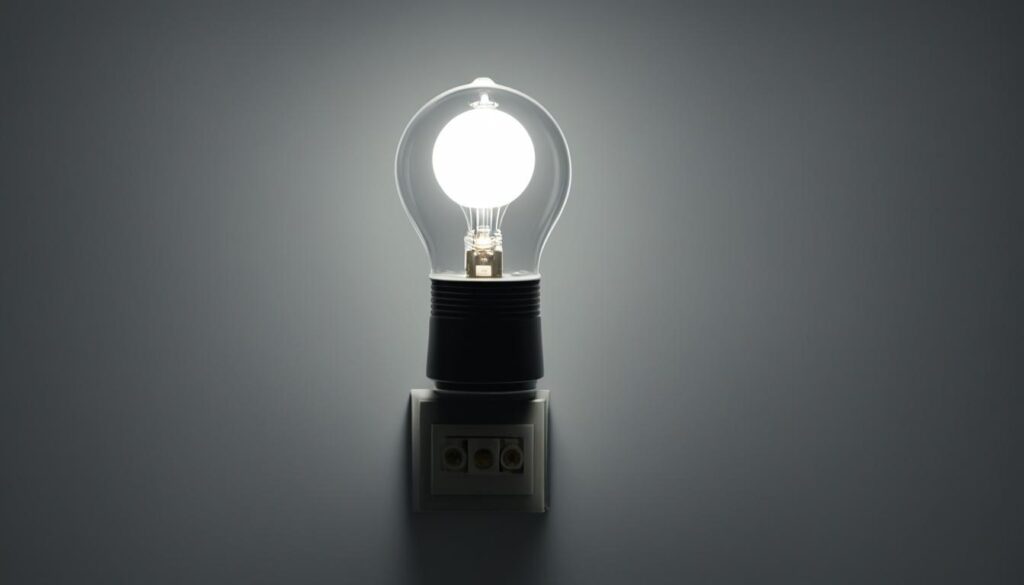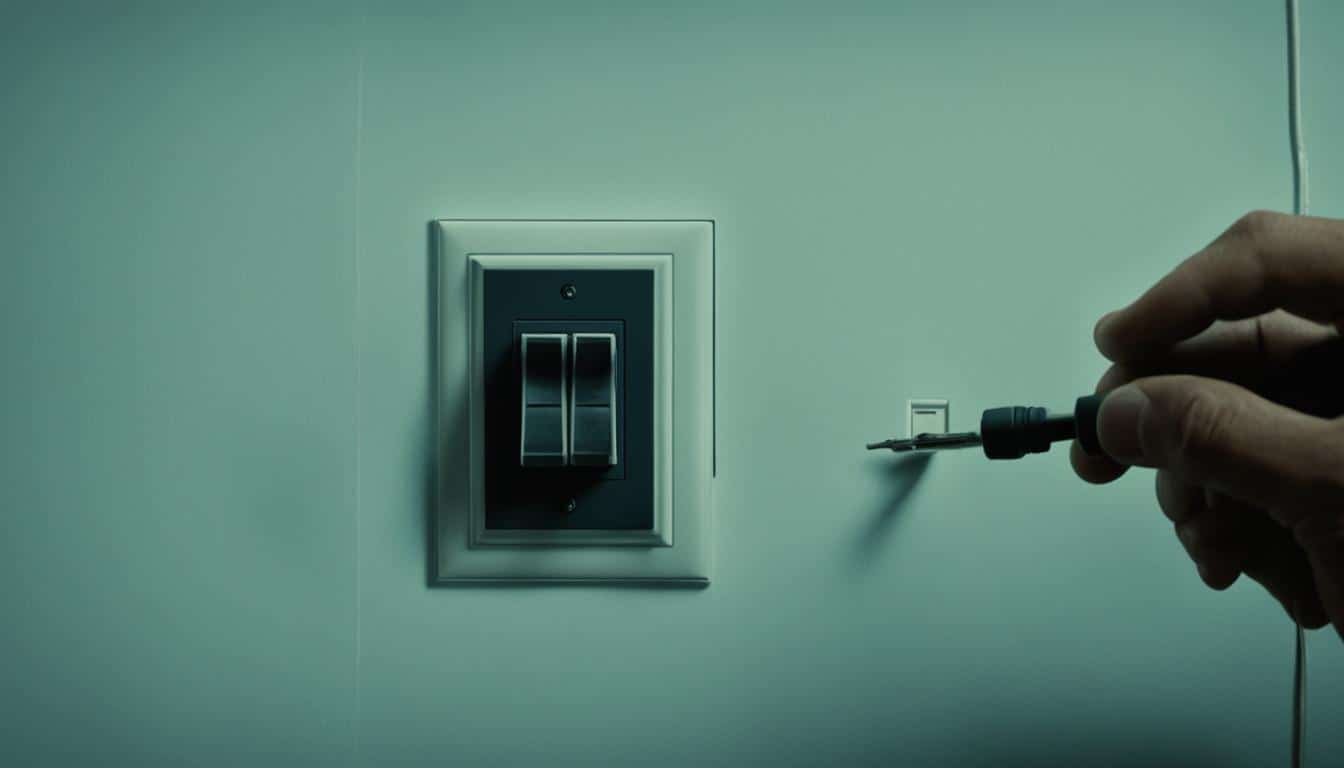Struggling with a perplexing LED light problem where the bulb remains dim even when the switch is off? We’ve been there and know just how frustrating LED light troubleshooting can be. Fear not, because we’re here to illuminate the steps on how to fix LED light issues that linger when it should be dark.
With some savvy guidance, you can pinpoint the cause of this dim light when the switch is off and implement a long-lasting solution. Join us as we explore the often puzzling world of LED afterglow and arm you with the knowledge to address it confidently.
Key Takeaways
- Identify that the LED afterglow is a common but fixable issue.
- Understand the energy retention in LED drivers as a potential cause.
- Acknowledge that improper wiring could contribute to the problem.
- Recognize the importance of quality bulbs in preventing afterglow.
- Learn the need for proper electrical inspections by professionals.
- Realize the role of Zener diodes and bypass capacitors in resolving this.
Understanding the Phenomenon of LED Afterglow
When we switch off a light, we expect it to go dark immediately. However, if you’ve ever noticed that your LED light stays on dim even after you’ve turned it off, then you’ve witnessed what’s commonly referred to as “LED afterglow.”
This curious behavior can be quite perplexing and is often mistaken for a fault within the lighting system. Yet, this glow that persists isn’t necessarily a sign that your LED light is not turning off due to a malfunction.
The source of this luminescence lies within the electrical components of the LED itself, specifically the inductors and capacitors. These components have the capacity to store a small amount of energy and, even when the power supply ceases, they discharge their stored energy slowly.
The duration and intensity of the afterglow vary. It largely depends on the type of LED lamp and can last from a few fleeting moments to several minutes. The indicators and capacitors within your LED bulbs are essentially releasing their residual energy, resulting in a dim light that lingers.
An awareness of this phenomenon helps us to approach the LED light stays on when switch off problem with a better understanding. Knowing that this afterglow is a characteristic of the electrical makeup of LEDs is the first step in effective troubleshooting and not an indication of a light that refuses to extinguish outright.
With this knowledge, we can better troubleshoot the scenario where an LED light maintains its glow. This is not an issue of faulty installation generally but an internality of the LED’s design. However, consistent or overly bright afterglow may suggest the need for further investigation into the quality of the bulbs or the wiring of the household.
Common Causes of Persistent Dimness in LED Lights
When you face the issue of a dim light when the switch is off, you’re likely experiencing one of two main culprits: the nature of the LED driver or the peculiarities of your home’s electrical wiring. Let’s illuminate these common causes.
Energy Storage in LED Drivers
LED drivers are the control centers for your LED lights, providing them with the power they need to shine bright. However, these drivers don’t always go dark immediately when you flick off the switch. Instead, they may retain some charge due to the electrical energy stored in their capacitors and inductors, leading to LED light flickering when switched off or maintaining a dim glow. While this discharge process is totally normal, it can be misinterpreted as a malfunction when, in reality, it’s simply physics at work.
Electrical Wiring Anomalies
Digging deeper into your home’s electrical maze can reveal other suspects for why an LED light won’t turn off entirely. Issues can range from inadequate insulation to an ungrounded neutral wire that allows a small electric current to leak through, giving enough juice for a ghostly gleam. Wiring mix-ups, such as accidental short-circuits, might not cut the connection cleanly, which can also be the reason behind the lingering light.

| Possible Cause | Effect on LED Lights | Troubleshooting Tip |
|---|---|---|
| Energy Stored in LED Drivers | Faint glow or flickering after being turned off | Wait a few minutes for the energy to dissipate |
| Incorrect Wire Insulation | Dim light persists due to small current leak | Inspect and replace insulation where necessary |
| Improperly Earthed Neutral Wire | Continual weak glow from the light source | Check grounding and secure connections |
| Accidental Short-Circuits | LED light stays on, defying switch position | Identify shorts and correct wiring layout |
LED Light Stays on Dim When Switch is Off: Electrical Considerations
For those puzzled by the LED light problem of lights remaining dimly lit even when the switch is off, it’s essential to prudently untangle the complexities of home electricity. We uncover the subtle nuances of wiring that may contribute to this persistent glow, guiding you through effective LED light troubleshooting tactics.
Induction and Resistance: Key Culprits
Our homes are webs of electrical circuits, and at times, they hold secrets like embedded induction and resistance issues. These hidden facets can make an LED exhibit a dim light when switch off. In such instances, the electrical pathways aren’t entirely dormant, as they stealthily harbor currents that shield the LED from total darkness. This is a crucial insight when diagnosing the quizzical occurrence of LEDs not switching off completely.
Switch and Dimmer Malfunctions Leading to LED Glow
Another frontier in our quest to correct LED lighting behavior lies in the mechanism of the switches and dimmers themselves. While designed to bring us convenience, these devices can unintentionally feed our LEDs with power due to standby functions. A switch with auxiliary features, gone rogue, can be the unsuspecting villain causing your dim light when switch is off.
To help visualize the troubleshooting process for a LED light problem, here’s a table laying out common symptoms and possible solutions:
| Symptom | Possible Cause | Potential Solution |
|---|---|---|
| LED remains dimly lit | Induction from cables | Ensure proper spacing and shielding of electrical wires |
| LED won’t switch off | Residual switch current | Check switch for malfunctions and consider replacement if necessary |
| Faint LED glow | Neutral wire issues | Verify neutral wire bonding and consult a professional if re-wiring is needed |
| LED fluctuating in brightness | Dimmer standby power | Install an appropriate dimmer or a bypass device to mitigate current leakage |
We understand that the switch is off, but the light remains—it’s a conundrum that can perplex even the most experienced of homeowners. Armed with the right knowledge and a methodical approach, we can ever so gently coax these LED lights back to their ideal state of restful darkness when not in use.
High-Quality LED Lamps: A Solution to Unwanted Glow
If you’ve been pondering how to fix LED light that stays on when switch is off, it’s essential to understand the impact of using high-quality LED lamps. Not all LED bulbs are created equal, and investing in superior products can significantly mitigate issues related to post-illumination. We’ll delve into why premium LEDs offer a brighter solution for those problematic glows.
High-quality LED lamps often use advanced technology to address the unwanted afterglow. These bulbs are likely to have built-in features that prevent the trickle of current that causes the LED to emit light even when your switch is in the off position. Let’s take a deeper look at what separates high-end LEDs from their counterparts.
| Feature | High-Quality LED Lamps | Standard LED Lamps |
|---|---|---|
| Component Quality | Use of premium components that reduce residual current flow | Basic components more prone to retaining current |
| Lifespan | Extended lifespan with lower degradation over time | Shorter lifespan, higher chance of afterglow developing with use |
| Warranty | Long-term warranties reflecting product reliability | Limited or no warranty, indicative of lower confidence in product |
| Price | Higher upfront cost, but long-term savings on replacements and electricity | Less upfront cost, but more frequent replacements and potential energy waste |
We believe that the slight increase in price for high-quality LED lamps is a worthwhile investment, especially when considering the reduced hassle of a glow that persists after switching off the light. Not only do they provide peace of mind, but these LEDs also enhance the overall ambiance of your space without unexpected luminescence during their off-hours.
Choosing a high-quality LED lamp is not only about preventing unwanted glow; it’s also about securing a reliable and efficient lighting solution that ensures a consistent performance without the caveats of lower-quality alternatives.
- Check for certifications and ratings – LEDs with safety and performance certifications (such as Energy Star) tend to offer a higher guarantee against afterglow issues.
- Read customer reviews – Users who have encountered the same issues can provide valuable insights into the performance of different LED lamp brands.
- Opt for reputable manufacturers – Established brands in the lighting industry are more likely to offer the sophisticated technology needed to combat unwanted glow.

In summary, we stand by the idea that choosing high-quality LED lamps should be the go-to solution for anyone struggling with how to fix LED light that stays on when switch is off. The benefits of such an upgrade go beyond solving the issue at hand, providing overall better value for your investment in the long run.
Troubleshooting Your Home’s Electrical Wiring for LED Issues
When we encounter an LED light problem, especially when the LED light stays on dim with the switch off, a systematic method of LED light troubleshooting is necessary. Before delving into potential solutions, it’s crucial first to understand that the source of such issues often lies within the home’s electrical system.
Professional Electrical Inspection
The first step to ensure your LED lights operate correctly is to engage a licensed electrician to perform a thorough inspection. Professionals come equipped with the expertise to examine the circuitry and detect any underlying concerns. They look for irregularities that could contribute to your LED light problem, giving special attention to the integrity of switches and connections which, if faulty, might explain why your LED appears to stay on when the switch is off.
Identifying and Fixing Cable Routing Errors
Another facet of addressing LED lighting issues is investigating and correcting any cable routing errors within your electrical system. Misrouted cables can create electromagnetic interference or induce voltage in the circuit even when the power is supposed to be cut off by the switch. Properly organized and secured wiring is fundamental to preventing additional currents from feeding into your LED lights inadvertently.
An inspection may highlight the need to reroute wiring or to replace certain electrical components to resolve the persistent dim glow. By meticulously diagnosing and remedying such flaws, we mitigate the risk of ongoing LED lighting glitches, ensuring the lights only operate when intended. Harnessing a combination of professional insight and troubleshooting techniques can efficiently resolve many common LED light issues, casting a brighter light on the path to a properly functioning electrical system.
Incorporating Zener Diodes to Combat LED Afterglow
For homeowners struggling with the common issue of how to fix LED light that stays on when switch is off, turning to Zener diodes might just be the perfect solution. These components are specifically designed to manage the unwanted afterglow effect of your LEDs by effectively blocking any voltage that falls below a specified threshold. This pivotal role played by Zener diodes makes them a critical element in LED light troubleshooting.
How Zener Diodes Regulate Circuit Voltage
When looking into LED light troubleshooting, understanding the functionality of Zener diodes is key. These diodes allow current to flow in a forward direction like any typical diode. However, when a reverse voltage is applied, and it reaches the Zener’s breakdown voltage, the current flows in reverse, but only above this threshold. This unique characteristic means they can be employed to keep the voltage over the LED constant, effectively avoiding the afterglow when the LEDs are meant to be off.
Installation Considerations for Zener Diodes
To ensure Zener diodes serve their purpose effectively, accurate installation is paramount. This involves using a multimeter to measure the circuit voltage and then selecting a Zener diode with the appropriate breakdown voltage. Mistakenly installing a diode in a reversed direction would prevent it from operating correctly, as it only allows voltage to pass when it’s above its enforced threshold.

Here’s a table that represents different Zener diode specifications and their respective uses in LED light circuits:
| Breakdown Voltage | Maximum Current | Typical Application |
|---|---|---|
| 4.7V | 1W | Low voltage LED circuits |
| 5.1V | 5W | Standard home LED circuits |
| 12V | 1W | Higher voltage lighting systems |
Knowing how to integrate these Zener diodes effectively into your lighting system is essential for rectifying the frustrating issue of an LED light that stays on when switch is off. With this knowledge, the phantom glow can be conquered, ensuring that your lights turn off fully, as intended.
How to Diminish LED Light Glow with Bypass Capacitors
Have you ever wondered why your LED light won’t turn off, or noticed LED light flickering when switch off? A common culprit behind these issues could be minimal leakage currents that persist even when your switches are turned to the off position. This can lead to the irritating problem of a dim light when switch off. The good news is that there’s a strategic solution to this: the installation of bypass capacitors.
These clever devices can absorb the residual voltage left by electronic dimmers, especially those not connected to a neutral wire. By integrating bypass capacitors into your lighting system at the power supply outputs of dimmers and switches, you can significantly minimize, if not altogether eliminate, the unwanted glow that emanates from your LED lights.
Bypass capacitors operate by providing an alternative path for the excess current, preventing it from contributing to the afterglow of your LED lights. While the application of such capacitors may sound complex, it is a practical step that many can accomplish with the right tools and guidelines. Let’s dive into how this process can make a considerable difference in maintaining the aesthetic and functionality of your indoor lighting.

- Identify the power supply outputs of your switches or dimmers.
- Disconnect the power supply to ensure safety before proceeding.
- Attach the bypass capacitors across the outputs.
- Ensure secure connections to avoid loose wires or potential malfunctions.
- Restore power and test your switches or dimmers to observe the improvements.
By following these steps, you will likely see an instant improvement in the performance of your LED lights. No longer will you have to deal with the jarring glow from a light that was supposed to be turned off. The tranquility of complete darkness, or the accuracy of well-placed light, can once again be yours. These technical adjustments can have a profound impact on the ambient quality of your living spaces.
Technology and Trends in LED Lighting Solutions
As we adapt to the ever-evolving world of technology, the LED lighting industry continues to make groundbreaking advances. These innovations are not just improving the functionality of LED lights but are also offering solutions to issues like an LED light that stays on when the switch is off, streamlining LED light troubleshooting, and addressing common LED light problems. At the forefront of these developments is LedStore, a revered authority in LED illumination technology.
LedStore’s Expertise in LED Illumination
With years of experience under its belt, LedStore stands as a beacon of excellence in the LED market. Their expertise is not limited to just providing lighting solutions but encompasses a deep understanding of the intricacies that make LED lighting systems more efficient and reliable. Witnessing a bulb that won’t turn off can be perturbing, but LedStore’s high-caliber products are crafted to tackle such challenges confidently, backed by warranties of up to 7 years.

The Importance of Proper Lighting Design
It’s not only about the bulbs; the way we design our lighting systems can significantly impact their effectiveness. Embracing proper lighting design is crucial; hence, LedStore champions the innovation of personalized LED solutions, including temperature control and high color rendering index (CRI) luminaires. Such tailored solutions not only prevent problems like the LED afterglow but also enhance the ambiance and functionality of spaces. To illustrate the state-of-the-art trends, let’s look at the comparison between traditional and modern LED lighting solutions.
| Traditional LED Lighting | Modern LED Solutions by LedStore |
|---|---|
| Standard CRI and color temperatures | High CRI, customizable color temperatures |
| Fixed shapes and dimensions | Custom-made LED strips in various profiles |
| Typical warranties of 1-2 years | Extended warranties up to 7 years |
| Generic troubleshooting support | Advanced technical support for LED light troubleshooting |
Conclusion
In our exploration of the persistent issue of LED lights staying dim even when the switch is off, we’ve unraveled the technical intricacies behind this phenomenon. From energy accumulation in LED drivers to the nuances of quality and electrical infrastructure, it’s evident that tackling LED light issues is a complex endeavor. Fortunately, concrete solutions like equipping circuits with Zener diodes and opting for higher-grade LED bulbs effectively mitigate these lighting frustrations. We’ve also highlighted the significance of consulting with seasoned electricians to ensure thorough troubleshooting and securing LED lighting setups that are not only functional but exemplary in performance.
LED light troubleshooting often extends beyond mere bulb replacement or switch adjustments. It embeds itself in a broader context of electrical knowledge and an appreciation for the intricacies of modern lighting technologies. When we encounter the situation where an LED light stays on dim when the switch is off, it compels us to analyze and correct the underlying causes with precision and informed action.
Ultimately, our quest for resolving issues, such as figuring out how to fix an LED light that stays on when the switch is off, directs us toward embracing innovative products from brands like LedStore. Their forward-thinking solutions offer us avenues to not only repair but enhance our lighting experiences. Above all, these insights empower us to forge ahead towards a future that is brightly lit with reliable, efficient, and sophisticated LED lighting solutions for our homes.
FAQ
Why does my LED light stay on dim even when the switch is off?
This phenomenon is known as LED afterglow. It can be caused by energy stored in the LED’s components or by small electrical currents still passing through due to wiring issues or the design of the switch or dimmer.
What causes energy storage in LED drivers that leads to afterglow?
LED drivers contain electrical components like inductors and capacitors, which can retain energy. When the power is switched off, this stored energy discharges slowly, causing the LED to emit a faint light.
How can electrical wiring anomalies contribute to a dim LED light when switched off?
Issues such as poor insulation, lack of a ground wire, or high resistance can cause a small amount of electricity to continue flowing to the LED, even when it should be off, resulting in a dim afterglow.
Could switches or dimmers be the reason my LED light stays on dim?
Yes, switches and dimmers with features like sensors, timers, or indicator lights could be providing a low voltage to the LED, which is enough to create a dim light when you expect the bulb to be off.
How can high-quality LED lamps reduce the unwanted afterglow?
High-quality LED lamps are designed with better components that can minimize energy retention. They also tend to have a more consistent performance with fewer flickering or afterglow issues.
What should I check in my home’s electrical wiring if my LED light won’t turn off?
It’s best to consult with an electrician to inspect the wiring, especially the routing of cables, to ensure there are no errors or issues like short-circuits that may be causing the persistent glow.
How do Zener diodes help fix LED lights that stay on when the switch is off?
Zener diodes can block voltages below a specific threshold, preventing the residual energy from reaching the LED light. Installing them correctly in the circuit can stop the afterglow effect.
What are the installation considerations for Zener diodes?
Zener diodes need to be selected based on the voltage of your LED circuit and installed with the correct orientation. Incorrect implementation could result in a diode that does not function as intended.
Can bypass capacitors diminish LED light glow?
Yes, bypass capacitors can absorb leakage current that might be left behind by electronic dimmers, particularly those without a neutral connection, thereby reducing the afterglow in LED lights.
What expertise does LedStore offer to address LED light problems?
LedStore specializes in LED technology and offers products with advanced technical specifications, including temperature control and high color rendering. They also provide guarantees for up to 7 years on their products.
Why is proper lighting design important for preventing LED afterglow?
Adequate lighting design ensures that LEDs operate within their optimal parameters and are paired with compatible dimmers and switches. This can reduce instances of afterglow and other lighting issues.

